Models and tools to build systems natively based on modelled traces.
-
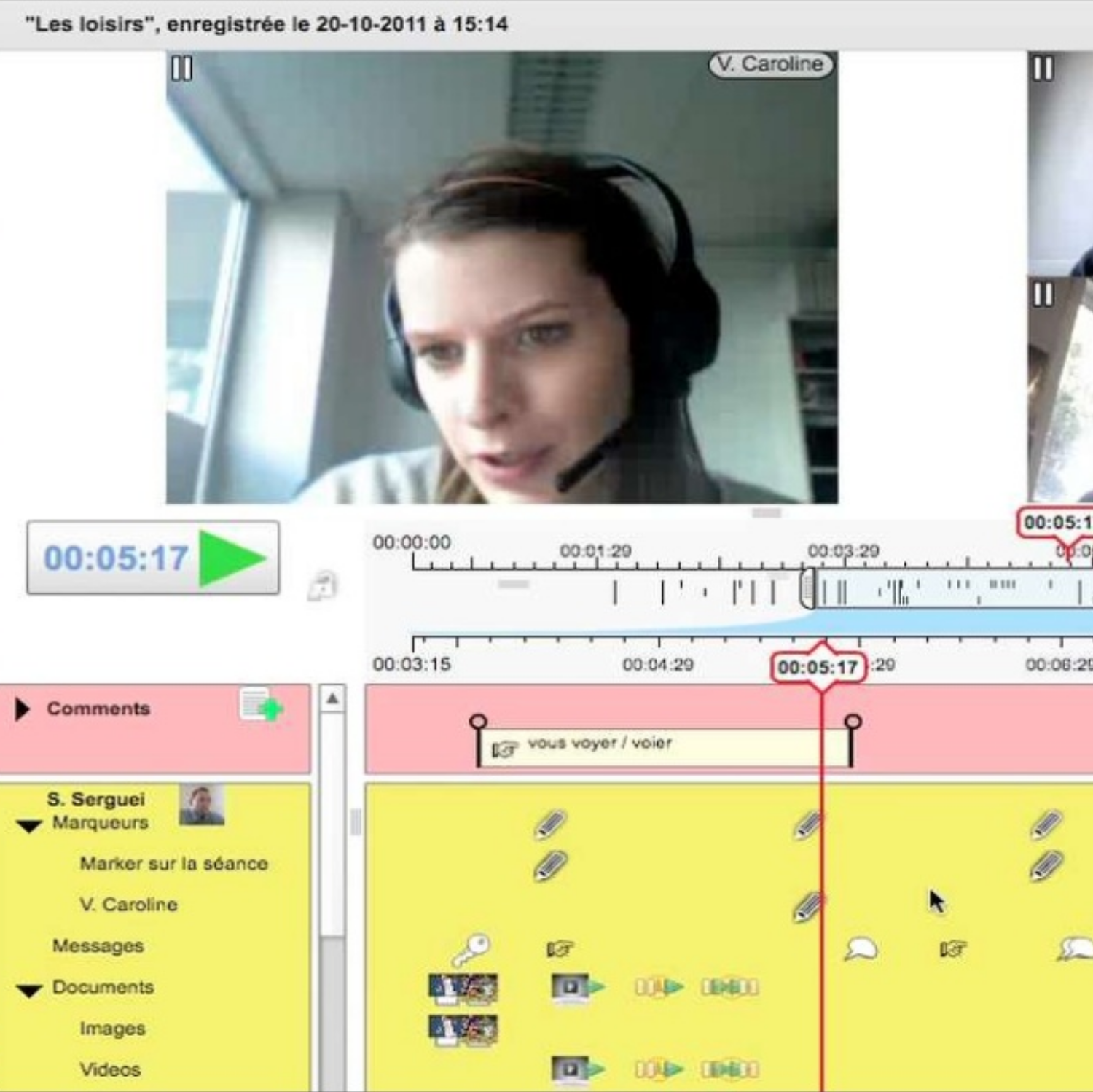
ITHACA: Interative Trace for Human Awareness in Collaborative Annotation
Reflective Systems
Technology-Enhanced Learning
Trace-based Systems
Video Annotations
In this project carried with education scientists, we explored the use of traces in synchronous videoconference-based communication, mainly in the context of language teaching. We built two versions of the Visu tool, that was used in multiple settings..
Details
Partners: LIRIS, Lyon 2 University, ICAR Laoratory, TECFA Geneva
Funding: French National Research Agency (ANR)
Beginning: 2008-10-01
End: 2011-12-31
Website: https://projet.liris.cnrs.fr/ithaca/
Related publications
-
Elise Lavoué, Gaëlle Molinari, Yannick Prié, Safè Khezami. (2015) Reflection-in-Action Markers for Reflection-on-Action in Computer-Supported Collaborative Learning Settings in Computers & Education, Volume 88, October 2015, Pages 129–142. doi Show abstract We describe an exploratory study on the use of markers set during a synchronous collaborative interaction (reflection-in-action) for later construction of reflection reports upon the collaboration that occurred (reflection-on-action). During two sessions, pairs of students used the Visu videoconferencing tool for synchronous interaction and marker setting (positive, negative or free) and then individual report building on the interaction (using markers or not). A quantitative descriptive analysis was conducted on the markers put in action, on their use to reflect on action and on the reflection categories of the sentences in these reports. Results show that the students (1) used the markers equally as a note-taking and reflection means during the interaction, (2) used mainly positive markers both to reflect in and on action; (3) paid more attention in identifying what worked in their interaction (conservative direction) rather than in planning on how to improve their group work (progressive direction); (4) used mainly their own markers to reflect on action, with an increase in the use of their partners' markers in the second reflection reports; (5) reflected mainly on their partner in the first reflection reports and more on themselves in the second reports to justify themselves and to express their satisfaction.
-
Elise Lavoué, Gaëlle Molinari, Safè Khezamy, Yannick Prié. (2013) How do Students Use Socio-Emotional Markers for Self-Reflection on their Group Work in CSCL Settings? A Study with Visu: a Synchronous and Delayed Reflection Tool in 10th International Conference on Computer Supported Collaborative Learning, Madison, USA, 2013 [AR:39%] Show abstract This paper describes an exploratory study on the use of reflective markers set during synchronous collaborative learning sessions (reflection in action) for later construction of self-reflection reports upon the collaboration that occurred (reflection on action). During 2 sessions, students used the Visu tool for interaction and marker setting (positive, negative, free) and then report building on the interaction (using markers or not). A quantitative descriptive analysis has been conducted on the markers used and on the reflective categories of the sentences in the reports. Results show that students (1) paid more attention in repairing their relationship than reflecting on learning and task goals; (2) used mainly positive markers to both reflect in and on action; (3) used more their partner's markers in the second reports; (4) reflected more on themselves in the second reports to justify successes and failures, and to express satisfaction.
-
Elise Lavoué, Safè Khezami, Gaëlle Molinari, Yannick Prié. (2013) The Visu Reflection Tool for Socio-Emotional Awareness in CSCL situations in Workshop on Tools and Technologies for Emotion Awareness in Computer-Mediated Collaboration and Learning. Alpine Rendez-Vous (ARV) 2013, Villars-de-Lans, Jan 2013. Show abstract An exploratory study has been conducted in which 12 students in Bachelor of Science in Psychology were asked to use the Visu reflection tool during Computer-Supported Collaborative Learning (CSCL) situations. Visu is a web videoconferencing platform that allows participants to put reflective markers during their collaborative learning activity, and to review the traces of their synchronous collaboration later. In this study, co-learners used two types of markers: (1) free markers and (2) socio-emotional markers to express either negative or positive feelings about the way they collaborate together. Our contribution is related to the first focus of the workshop: emotion awareness in CSCL. In line with this focus, our main questions are as follows: (1) How can the Visu tool help learners express and share their feelings about collaboration? How does this affect the way they interact and learn together? (2) How do they use the Visu markers after the collaboration to self-reflect on their group processes? In this paper, we first describe the Visu platform. We then present a study we have carried out to answer the questions presented above. We finally conclude with the contributions of our research to the workshop topic.
-
Nicolas Guichon, Mireille Bétrancourt, Yannick Prié. (2012) Managing written and oral negative feedback in a synchronous online teaching situation in Computer-Assisted Language Learning, 25(2):181-197, 2012. doi Show abstract This case study focuses on the feedback that is provided by tutors to learners in the course of synchronous online teaching. More specifically, we study how trainee tutors used the affordances of Visu, an experimental web videoconferencing system, to provide negative feedback. Visu features classical functionalities such as video and chat, and it also offers a unique marking tool that allows tutors to take time-coded notes during the online interactions for later pedagogical remediation. Our study shows that tutors mainly use verbal and chat feedback, with significant inter-individual variability, and that tutors who provide verbal feedback are more likely to use markers. Marking takes time because of the dual task that it entails for the tutor. Idiosyncratic strategies in the use of markers are evidenced. These results clearly show the value of markers for negative feedback, signal the need for their explicitness, and also call for an evolution of the Visu interface so that tutors can better negotiate the task of online tutoring and the pedagogical stance they have to take on in their interactions with the learners.
-
Mireille Bétrancourt, Nicolas Guichon, Yannick Prié. (2011) Assessing the use of a Trace-Based Synchronous Tool for distant language tutoring in 9th International Conference on Computer Supported Collaborative Learning. Hong Kong. pp 486-493. Jul 2011. [AR:36%] Show abstract This article presents a pilot study carried out to investigate the potential of a functionality marker setting, included in a synchronous collaborative videoconferencing platform (VISU). Markers, supported by a trace-based system, are designed to facilitate tutors' activity. They provide tutors with (1) the possibility of annotating their distant learners' learning activity, and (2) information pertaining to their own behavior during pedagogical interaction, which can potentially enhance their professional performance as online language tutors. This study concentrates on the marker-based traces of eight language tutors collected in the course of pedagogical interactions with their distant learners during a seven-week transnational collaborative project. It presents both quantitative and qualitative analyses of the use of markers during synchronous language teaching sessions and assesses the utility and usability of such a functionality for language tutoring in order to inform future design and training.
Related software
-
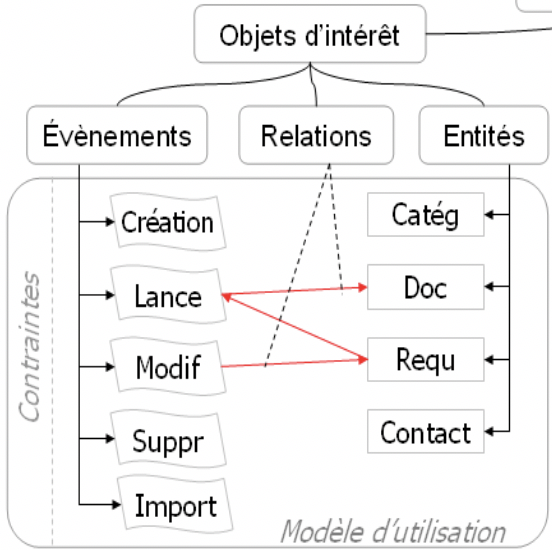
Musette: Modelling USEs and Tasks for Tracing Experience
Knowledge Engineering
Trace-based Activity Analysis
Trace-based Systems
A first tentative towards modelling information systems use experience as traces, going from Case-Based reasoning to Trace-based reasoning, with a modelled approach to traces, and episodes querying to foster user assistance and activity analysis.
Details
Partners: false
Funding: various
Beginning: 2000-10-01
End: 2005-12-31
Related publications
-
Julien Laflaquière, Yannick Prié. (2009) Musette : Modéliser les Usages et les Tâches pour Tracer l'Expérience in Réutilisation de l'expérience : modèles et applications, Hermès, 2009. Show abstract L’objectif général de ce chapitre est de présenter l’approche Musette – Modéliser les USages et les Tâches pour Tracer l’Expérience – développée au LIRIS depuis plusieurs années.
-
Pierre-Antoine Champin, Yannick Prié and Alain Mille. (2004) MUSETTE: a Framework for Knowledge Capture from Experience in short paper in EGC'04, Clermont Ferrand, jan. 2004 Show abstract Nous présentons dans cet article une nouvelle approche de modélisation de l'expérience d'utilisation d'un système informatique, avec pour objectif de réutiliser cette expérience en contexte pour assister l'utilisateur à effectuer sa tâche. Le modèle se base sur la capture d'une trace d'utilisation conforme à un modèle d'utilisation général, lequel décrit les objets et les relations manipulés par l'utilisateur du système informatique visé. Cette trace primitive peut être considérée comme une base de connaissances neutre par rapport à la tâche, qui peut être analysée a posteriori à l'aide de signatures de tâche expliquées permettant d'y localiser des épisodes signifiants qui pourront être réutilisés par des assistants logiciels comme connaissances contextualisées. Quatre scénarios illustrent cette approche. (paper in english)
-
Julien Laflaquière, Yannick Prié. (2003) Modélisation d'utilisation de système pour une assistance à base de trace : une application de MUSETTE à la tâche de veille documentaire in Workshop Traces, interactions, co-constructions collectives et relations à la cognition. AS CoMETE, Paris, 19 déc. 2003. Show abstract La complexification des activités de haut niveau s'appuyant sur des outils informatiques et la généricité grandissante de ces mêmes outils, posent la question de la (re)définition de la place et du rôle de l'assistance relativement à ces activités et à ces outils. Cet article présente une approche de modélisation d'utilisation (MUSETTE), destinée à la création d'une assistance basée sur la réutilisation d'expérience, ainsi que sa mise en ½uvre dans le domaine particulier de la veille. Ce travail a débuté lors d'un stage de DEA au LIRIS. La réutilisation d'expérience dans une assistance visant spécifiquement une activité de haut niveau est une réponse possible, au problème de (re)définition de l'assistance, se démarquant d'approches plus « classiques ». L'approche globale MUSETTE et trois étapes clefs de modélisation sont développées, les perspectives offertes par ce travail sont discutées.
-
Pierre-Antoine Champin and Yannick Prié. (2003) Musette: uses-based annotation for the Semantic Web in Annotation for the Semantic Web, S. Handschuh (ed.), IOS Press, Amsterdam, pp. 180-190, 2003. Show abstract In Tim Berners-Lee’s vision of the Semantic Web, software agents must be able to retrieve knowledge relevant to the end-user’s task, despite the heterogeneity and scale issues which are inherent to the web. Annotating web resources is considered a promising way to achieve this vision. We argue in this chapter that every actual use of a resource may provide useful knowledge about that resource and therefore should annotate it. We propose a framework for taking uses into account and annotating resources with their uses. This framework is the result of a generalization effort in our team after a number of projects focusing on modeling uses and experience. We believe that this framework is relevant to the Semantic Web where uses-based annotation may prove valuable.
-
Elöd Egyed-Zsigmond, Alain Mille, Yannick Prié́. (2003) Club (Trèfle) : a use trace model in 5th International Conference on Case-Based Reasoning, LNCS, volume 2689, Trondheim, NO, pp. 146–160. [AR:21%] doi Show abstract In this paper we present a use trace model which allows the collection and reuse of user experience, based on a homogeneous and interconnected representation of users, procedures and objects. All these notions form a connected labeled directed graph containing highly connected and explained use traces. This model enables assistance in non trivial, creativity requiring situations. Our model uses the Case Based Reasoning (CBR) paradigm in order to reuse experience. After a formal description of the model we discuss how it can serve to capitalize and re-use experience.
-
Pierre-Antoine Champin, Yannick Prié. (2002) Modéliser l'utilisateur ou l'utilisation ? in Document Virtuel Personnalisable 2002, Brest, july 2002, pp. 97-102. Show abstract Les modèles d’utilisation nous semblent au moins aussi légitimes que les modèles d’utilisateurs pour piloter la personnalisation. En effet, personnaliser un document virtuel revient à influer sur ses modes d’utilisation pour faciliter la tâche de l’utilisateur, et donc nécessite de modéliser son utilisation. Or d’une part, il n’existe pas de relation bi-univoque entre utilisation et utilisateur : le même utilisateur a souvent plusieurs tâches à effectuer, pour lesquelles ses préférences peuvent varier grandement ; inversement, des utilisateurs effectuant les mêmes tâches devraient pouvoir partager des traits de personnalisation — dans le contexte de cette tâche. D’autre part, modéliser l’utilisation à partir d’un modèle de l’utilisateur implique un changement d’objet de modélisation (utilisation/utilisateur), et donc l’utilisation de méta-connaissances, souvent introduites a priori, sur les correspondances entre ces modèles, et dont l’acuité conditionne la pertinence de la personnalisation proposée. À l’inverse, personnaliser à partir d’un modèle d’utilisation évite d’avoir à changer d’objet de modélisation. Nous développons l’idée que les traces d’utilisation devraient être prises en compte pour la personnalisation de documents virtuels, et nous en proposons un modèle issu de nos travaux récents. Nous donnons également quelques exemples de réutilisation des usages pour la personnalisation de documents virtuels.
-
Pierre-Antoine Champin, Yannick Prié, Alain Mille. (2002) Conteneurs de connaissances : une approche fondée sur les usages pour le Web sémantique in Reconnaissances de Formes et Intelligence Artificielle, 2002, Angers, 10 pp. Show abstract Dans la vision du Web Sémantique proposée par Tim Berners-Lee, les agents logiciels doivent être capables de retrouver des connaissances pertinentes pour la tâche d'un utilisateur. Nous proposons dans cet article un cadre général pour prendre en compte les usages, centré sur la notion de conteneur de connaissances, et sur des modèles d'utilisation de ces conteneurs. Nous présentons ensuite deux projets dans lesquels les auteurs sont impliqués, où ce cadre est implanté : ARDECO, qui vise à assister la réutilisation en CAO, et RECIS, dont le sujet est l'indexation du contenu de documents audiovisuels. Nous concluons que toute utilisation d'une ressource devient annotation de cette ressource, et constitue ainsi un nouveau conteneur de connaissances.
-
Pierre-Antoine Champin, Yannick Prié, Alain Mille. (2001) Annotating with uses: a promising way to the semantic web in Workshop on Knowledge Markup and Semantic Annotation, K-CAP 2001, S. Handschuh, R. Dieng, S. Staab (Eds.), Victoria, oct. 2001, pp. 79-86. Show abstract In Tim Berners-Lee's vision of the Semantic Web, software agents must be able to retrieve knowledge relevant to the end-user's task, despite the heterogeneity and scale issues which are inherent to the web. We argue in this paper that users' tasks are themselves quite numerous and various, so that they can not be all predicted, and hence implemented. Therefore, considering actual uses may be an efficient way of fulfilling users' unpredicted needs. We propose a general approach for taking uses into account. Then we present how this approach was applied in two projects involving the authors: ARDECO, aiming at assisting the reuse of CAD documents, and RECIS, aiming at content-based retrieval of audiovisual documents. After a comparison of this approach with other works related to the Semantic Web, we conclude that any use of a resource should annotate this resource, and that such annotations, as they provide additional knowledge about the resource, should become part of the Semantic Web as resources of their own.
-
Yannick Prié, Alain Mille. (2000) Reuse of knowledge containers: a "local semantics" approach in Workshop on Flexible Strategies for Maintaining Knowledge Containers, 14th European Conference on Artificial Intelligence ECAI 2000, Mirjam Minor (Ed.), Berlin, Aug. 2000, pp.38-45. Show abstract In this paper we present two ways of considering reuse of systems of terms as knowledge containers. The rigorous approach is concerned with strict organization of terms and inferences, while the lazy one is based on terms used in various different contexts, without strictly predefined semantics. We argue that it is necessary to handle both advantages of such approaches in a median one, and present the AI-Strata model for description and use of audiovisual documents. This model has interesting properties that could help use and reuse term systems in different tasks and contexts.
Additional illustrations
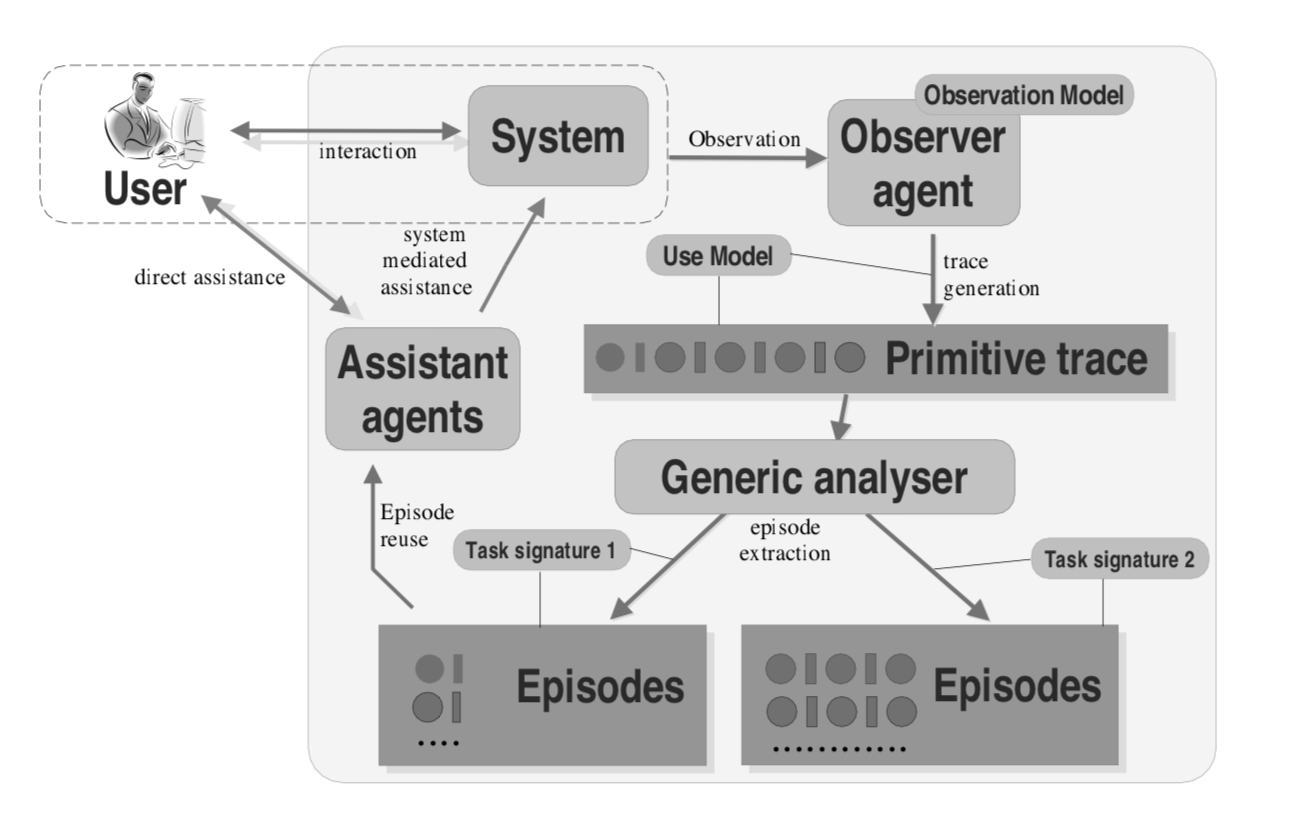
-
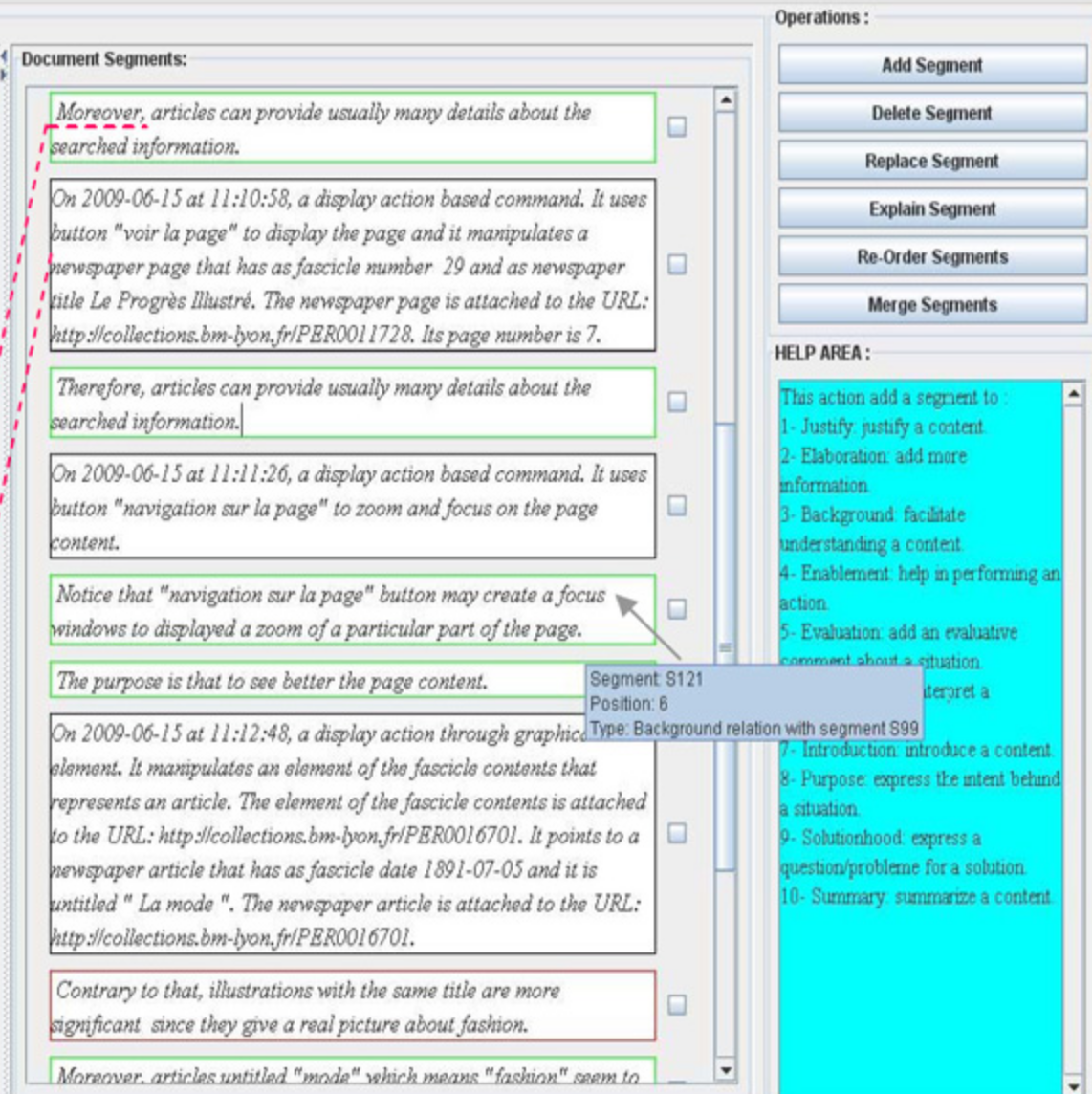
Redoc: Activity traces redocumentation
Document Engineering
Knowledge Engineering
Reflective Systems
Trace-based Systems
The redocumentation process of computer-mediated activity is as a narrative construction that ties together contents of activity traces and users’ knowledge of their own activities within exchangeable documents. We built a system for redocumenting the traces of exploring a 19th century newspaper digital library.
Details
Partners: LIRIS
Funding: University of Constantine
Beginning: 2008-10-01
End: 2012-10-à1
Related publications
-
Leila Yahiaoui, Yannick Prié, Zizette Boufaïda. (2013) Du traçage de l’activité informatique à sa redocumentation en texte in Technique et science informatique, n°1/2013 pp. 7-40, 2013. doi Show abstract Dans ce travail, nous présentons une approche générique pour le processus de redocumentation de l’activité médiée informatiquement. Cette approche combine le contenu de traces de l’activité et les connaissances des utilisateurs dans des formes narratives textuelles, facilement échangeables, décrivant l’activité de façon personnalisée pour les utilisateurs. Elle utilise des modèles formels pour les traces et les documents produits, ainsi que les principes de la théorie de la structure rhétorique(RST). Elle soutient la redocumentation à travers deux phases : une phase automatique pour générer un document texte initial et une phase interactive pour personnaliser ce document. Nous présentons notre outil de redocumentation ActRedoc, une implémentation de notre approche, ainsi que les résultats de sa première évaluation.
-
Leila Yahiaoui, Yannick Prié, Zizette Boufaïda, Pierre-Antoine Champin. (2012) Redocumenting computer mediated activity from its traces: a model-based approach for narrative construction in Journal of Digital Information, vol. 12. n°3. 2011. Show abstract Our activities are becoming more and more computer-mediated. For documenting these activities, it is no longer sufficient to automatically record their traces. In this paper we introduce the redocumentation process of computer-mediated activity as a narrative construction that ties together the content of activity traces and the users’ knowledge in describing their activities in new easily exchangeable documents. We present a generic semi-automatic approach for this process, which is based on rhetorical structure theory. This approach uses formal models for process input and output, and handles the process through two main phases: an automatic phase to generate a fragmented document from traces as a first description of the activity and an interactive phase to allow the user to tailor this first description according to his particular needs and choices. We also present ActRedoc, a tool developed for text-based redocumentation, for which a first evaluation was conducted.
-
Leila Yahiaoui, Zizette Boufaïda, Yannick Prié. (2010) Un outil générique pour la redocumentation en texte d'une activité médiée informatiquement in 1ére conférence Maghrébine sur l'Extraction et la Gestion des Connaissances (EGC-M 2010), Alger, Algérie. pp. 73-84. 2010. Show abstract Dans ce papier nous présentons un outil générique de redocumentation (semi-automatique) en texte d’une activité médiée informatiquement. Il s’agit d’un outil pouvant assister son utilisateur à exploiter les traces générées automatiquement, après leur modélisation sémantique, pour générer un nouveau document personnalisé décrivant l’activité tracée de façon plus appropriée. Cela consiste à réarranger le contenu des traces, à filtrer ce contenu, à reformuler certaines de ses parties et à ajouter des informations sur le contexte de production des traces. De plus, une forme d’appropriation peut être appliquée au document texte final. Il s’agit d’un document facilement échangeable, que ce soit à des fins d’analyse ou à des fins d’assistance. L’outil de redocumentation développé exploite différentes technologies du Web Sémantique. Il est basé sur les principes de la théorie de la structure rhétorique et ceux de la composition de documents personnalisés.
-
Leila Yahiaoui, Yannick Prié, Zizette Boufaïda. (2009) The redocumentation process of computer mediated activity traces: A general framework in 20th ACM Conference on Hypertext and Hypermedia (HT 2009), Torini, Italy, pp. 363-364, jul 2009 (Poster) Show abstract The digital world enables the creation of personalized documents. In this paper we are interested in describing a computer mediated activity by a person throughout a semi-automatic redocumentation process. This process uses traces generated automatically, during a user-system interaction, to assist a person in producing a personalized document describing the traced activity. To support that, a general framework for an authoring tool is proposed through two main phases. During the first phase, an automatic and parameterized transformation is applied on the input activity trace to generate a fragmented document. Each fragment describes one or many observed elements of the modeled trace and relations between fragments are deduced from relations between these elements. The second phase consists in interactive transformations on the intermediate produced document until getting the final hypermedia document. Our authoring tool uses composition of personalized document issues and RST principals to interpret user's choices and to maintain the coherence of the produced document.
-
Leila Yahiaoui, Yannick Prié, Zizette Boufaïda. (2008) Redocumentation des traces d'activité médiée informatiquement dans le cadre des transactions communicationnelles in 19es Journées Francophones d'Ingénierie des Connaissances (IC 2008), Nancy, France. pp.197-209, Jun 2008 Show abstract La documentation de l'activité médiée informatiquement est souvent assurée par l'ensemble des fichiers traces générés suite à l'interaction de l'utilisateur avec le système informatique utilisé. Or ces documents traces manquent de lisibilité, d'intelligibilité et de portée sociale. Dans cet article nous présentons une nouvelle approche de redocumentation de l'activité médiée informatiquement, dans le cadre de la théorie des transactions communicationnelles. Cette redocumentation se base sur l'exploitation des traces d'interaction dans le but de créer un nouveau document numérique décrivant cette activité. Ce document, personnalisé par l'utilisateur ou d'autres personnes, offre aux traces un statut documentaire plus renforcé, dans le but de mémoriser l'activité de l'utilisateur tracé, d'interpréter son comportement ou d'assister d'autres utilisateurs ayant une activité similaire. Nous présentons également un scénario de notre approche ainsi que certains problèmes posés.
Additional comments
PhD thesis of Leila Yahiaoui, between University of Lyon and University of Constantine, Algeria.
Additional illustrations
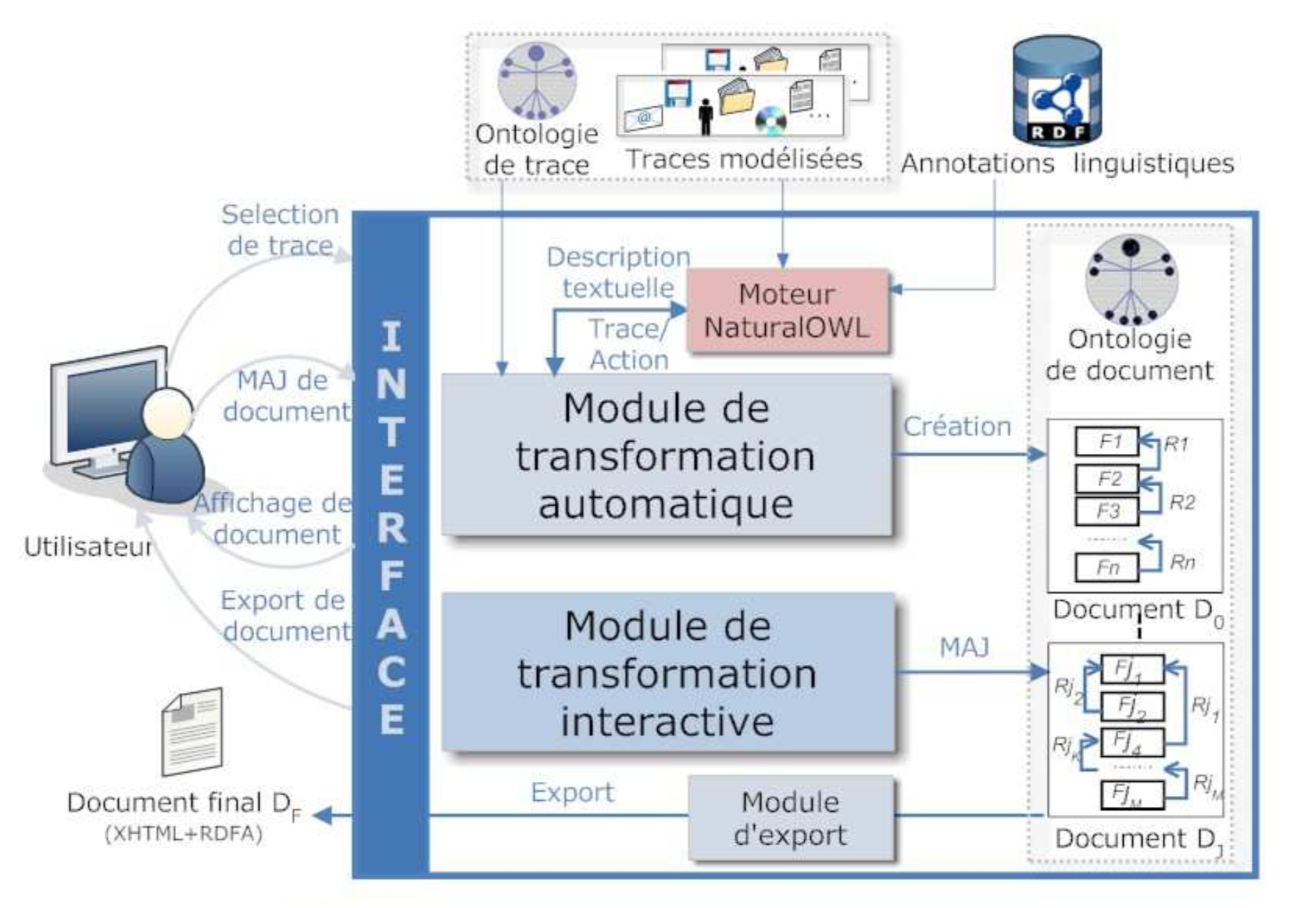
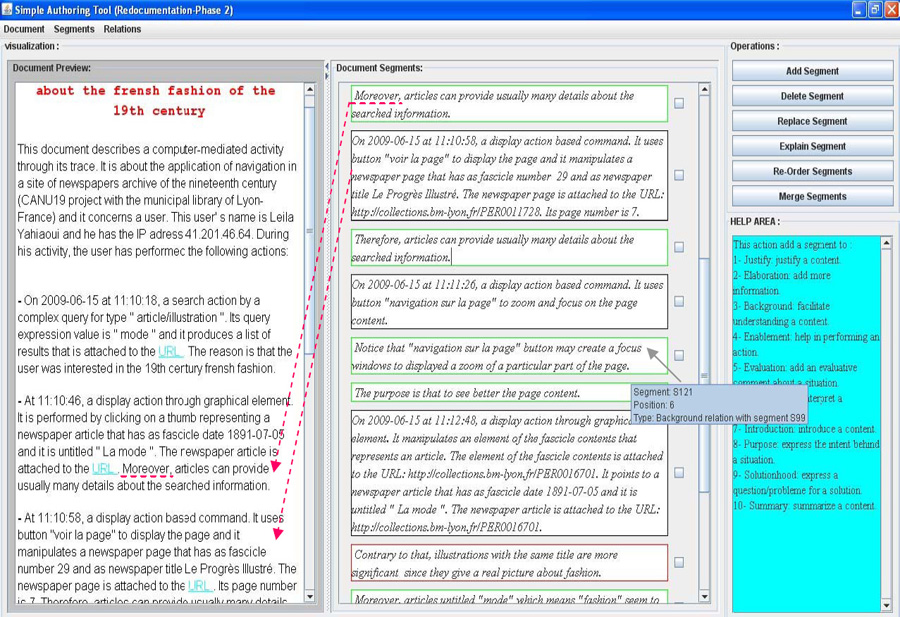
-
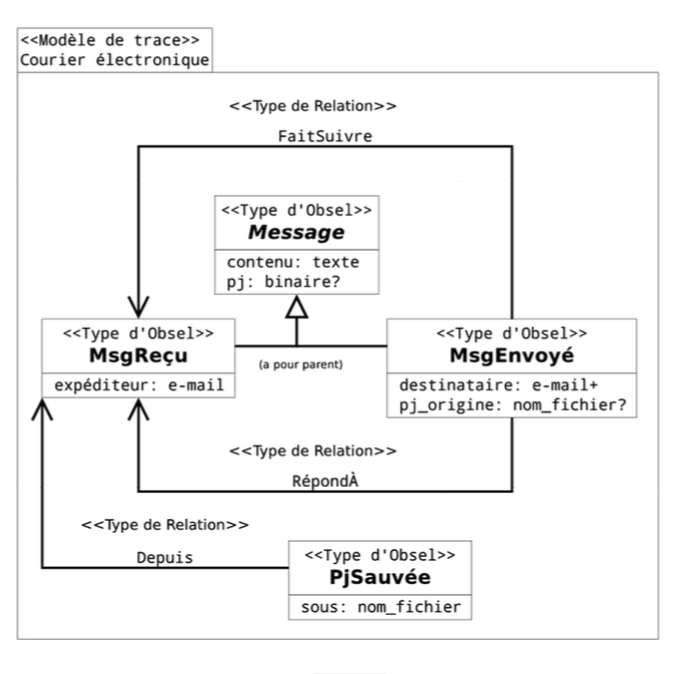
TBS: Trace-Based Systems
Knowledge Engineering
Trace-based Activity Analysis
Trace-based Systems
The main research axis of the SILEX team at LIRIS around Modelled-trace-based systems for activity analysis and user reflexivity, before it was called learning analytics. General knowledge-based modelling of Trace-bases systems, with a semantic web flavour, and lors of applications in various educational context
Details
Partners: A lot
Funding: Various projects
Beginning: 2007-01-01
End: 2013-01-01
Related publications
-
Pierre-Antoine Champin, Alain Mille, Yannick Prié. (2013) Les traces numériques comme objets de premier niveau : une approche par les traces modélisées in Intellectica, 2013-1 n°59, pp. 171-204, 2013. Show abstract Toute activité médiée par l’outil informatique laisse des traces numériques qui constituent en puissance des connaissances utiles, pour cette activité ou des activités futures. L’approche proposée dans cet article vise à exploiter effectivement ces connaissances dans des systèmes informatiques dits à base de m-traces. Cette approche consiste à proposer une modélisation a priori des traces, et à capturer leurs diverses interprétations possibles dans des transformations reproductibles. Nous proposons un méta-modèle général des systèmes à base de traces modélisées, et illustrons sa mise en œuvre dans deux applications. Nous discutons des défis que pose la conception de tels systèmes, notamment pour la prise en compte pluridisciplinaire de l’activité humaine tracée.
-
Olivier Curé, Yannick Prié, Pierre-Antoine Champin. (2012) Extending Knowledge-Based Systems to Reason Over Interaction Traces in The 18th International Conference on Knowledge Engineering and Knowledge Management EKAW 2012, Galway, oct 2012, 10p [AR:29%] Show abstract This paper presents a trace-based framework for assisting personal- ization and enrichment of end-user experience in an application. We propose a modular ontology-based architecture, to provide semantics for interaction traces, observed elements and their associated objects, and we extend existing inference services, with a declarative and generic approach, in order to reason with those interaction traces. We present the architecture of our framework and its reasoning levels, provide a proof of concept on a medical Web application, and emphasize that different kinds of actors can benefit from the supported inferences.
-
Damien Clauzel, Karim Sehaba, Yannick Prié. (2011) Enhancing synchronous collaboration by using interactive visualisation of modelled traces in Simulation Modelling Practice and Theory Journal. 19(1). pp. 84-97, 2010. doi Show abstract This article addresses issues related to traces modelling for formally describing human interactions of people engaged in a synchronous collaborative learning activity. The objective is to propose models and tools for representing, transforming, sharing and visualising traces of users’ experiences. The traces here represent the users’ activities in their interactions with the learning platform. Our proposition is based on reflexive learning defined as the ability to interact with the situation, in order to meet one’s own limitations. This work takes place in the ITHACA project which aims at developing an on-line learning platform that uses interaction traces as knowledge sources on, and for, the learners’ learning as individuals or groups. In this paper, we propose a general framework for trace management and sharing, a generic model of synchronous collaborative activity based on the notion of interaction modes that we specialized for whiteboard sharing and text chatting, and a conceptual framework for modelling the exploitation of modelled traces, in particular for interactive visualisation on the user side. This article extends our previous work [1] on the instrumented prototypes, by presenting our theorisation of the interactive visualisation of modelled traces.
-
Olivier Champalle, Karim Sehaba, Alain Mille, Yannick Prié. (2011) A framework for observation and analysis of learners’ behavior in a full-scope simulator of a nuclear power plant - Approach based on modelled traces in ICALT 2011 - The 11th IEEE International Conference on Advanced Learning Technologies</span>, Athens, Georgia, USA. July 2011. (Poster) doi Show abstract Our work deals with the subject of activity observation in full scope simulators. In this paper we present a Modelled Trace approach for designing a methodological framework and associated tools to manage the observation process and the corresponding analysis activity.
-
Olivier Champalle, Karim Sehaba, Alain Mille, Yannick Prié. (2011) Des transformations à bases de règles pour capitaliser et partager l’expertise d’observation de l’activité sur simulateur pleine échelle in IC 2011 - 22èmes Journées francophones d’Ingénierie des Connaissances</span>, Chambéry , France. 2011. (Poster) Show abstract Notre travail porte sur l’aide à l’observation et à l’analyse de l’activité dans les simulateurs pleine échelle de centrale nucléaire à l’Unité de Formation Production Ingénierie d’EDF. Les concepts clefs de notre approche sont basés sur la théorie de la trace modélisée développée par l’équipe SILEX afin de proposer un cadre méthodologique et les outils associés pour capitaliser, gérer et partager l’expertise d’observation.
-
Olivier Champalle, Karim Sehaba, Alain Mille, Yannick Prié. (2011) Observation et analyse de comportements collectifs et/ou individuels par la découverte de connaissances issues de l’exploitation d’un corpus de M-Traces d’activité sur simulateur pleine échelle in EIAH 2011 - Environnements Informatiques pour l’Apprentissage Humain, Mons - Belgique. 2011. 2p (Poster) Show abstract Nos travaux s’inscrivent dans le domaine de l’aide à l’observation de l’activité dans les EIAH de type simulateur pleine échelle de conduite de centrale nucléaire. Dans cette communication, nous présentons une démarche fondée sur la théorie de la trace modélisée dans le but de proposer un cadre méthodologique et les outils associés pour assister et gérer l'activité d'observation.
-
Tarek Djouad, Lotfi Sofiane Settouti, Yannick Prié, Christophe Reffay, Alain Mille. (2010) Un Système à Base de Traces pour la modélisation et l'élaboration d'indicateurs d'activités éducatives individuelles et collectives. Mise à l'épreuve sur Moodle in Technique et science informatique. 29(6). pp. 721-741, 2010. Show abstract Nous présentons dans ce travail un Système à Base de Trace implémenté pour le calcul des Indicateurs dans la plateforme d’apprentissage Moodle (SBT-IM). Nous présentons d’abord un cadre conceptuel permettant de penser tout système exploitant des traces modélisées en définissant les notions de trace, de modèle de trace et de transformation. Nous décrivons ensuite la mise en oeuvre de ce cadre conceptuel dans le cas d’un système à base de trace dédié au calcul des indicateurs dans les situations d’apprentissage collaboratif.
-
Julien Laflaquière, Yannick Prié. (2009) Interactive trace visualization in Trace-based systems in Workshop Interacting with temporal data at CHI 2009. Boston, MA, April 2009. 4pp. Show abstract We first introduce the notions of modeled-traces (M-traces) and trace-based systems. We then present activity analysis and activity support as the two main uses of M-traces, and we discuss interactive visualization challenges related to active reading of traces.
-
Lotfi-Sofiane Settouti, Yannick Prié, Jean-Charles Marty, Alain Mille. (2009) A Trace-Based System for Technology-Enhanced Learning Systems Personalisation in 9th IEEE International Conference on Advanced Learning Technologies, Riga, Latvia. 2009. [AR:27%] doi Show abstract This paper deals with the subject of personalization in technology-enhanced learning (TEL) Systems. As we want user centred solutions, we claim that considerable advantage can be gained from allowing observation and interpretation of learnerspsila interactions traces in TEL systems. The key concepts of our approach are modelled traces, and trace transformations. These transformations such as abstraction or filtering enable a better understanding of the interactions taking place in the TEL systems and allow to provide services for personalization.
-
Damien Cram, Béatrice Fuchs, Yannick Prié, Alain Mille. (2009) Découverte complète et interactive de motifs temporels avec contraintes numériques à partir de séquences d'événements in Atelier "Fouille de données temporelles et analyse de flux de données" à EGC2009, Strasbourg. jan 2009. 6p. Show abstract Nous proposons une méthode complète d'extraction de motifs temporels fréquents avec contraintes numériques à partir d'une séquence d'événements. Ces motifs, appelés chroniques, sont très expressifs par rapport aux motifs séquentiels plus « classiques » tels que les épisodes parallèles ou en série, ce qui implique une grande complexité dans la résolution complète. Un algorithme de résolution permettant l'introduction d'heuristiques et de contraintes utilisateur est proposé. Il est ensuite discuté comment mettre à profit les interactions avec l'utilisateur pour compenser sa grande complexité et le rendre praticable.
-
Damien Clauzel, Karim Sehaba, Yannick Prié. (2009) Modelling and visualising traces for reflexivity in synchronous collaborative systems in International Conference on Intelligent Networking and Collaborative Systems (INCoS 2009), Barcelona, Spain. pp. 16-23. 2009 doi Show abstract This article addresses issues related to traces modelling and visualization in synchronous collaborative learning. The objective is to propose models and tools for representing, transforming, sharing and visualizing traces of users' experiences. The traces here represent the users' activities in their interactions with the learning platform. Our proposition is based on reflexive learning defined as the ability to interact with the situation, in order to meet one's own limitations. This work takes place in the ITHACA project which aims at developing an online learning platform that uses interaction traces as knowledge sources on, and for, the learners' learning as individuals or groups. In this paper, we propose a general framework for trace management and sharing, a generic model of synchronous collaborative activity based on the notion of interaction modes, which we specialized for whiteboard sharing and text chatting. We modelled an IRC client and developed a first implementation.
-
Lotfi Sofiane Settouti, Yannick Prié, Damien Cram, Pierre-Antoine Champin, Alain Mille. (2009) A Trace-Based Framework for supporting Digital Object Memories in 1st International Workshop on Digital Object Memories (DOMe'09) in the 5th International Conference on Intelligent Environments (IE 09), Barcelona, Spain. IOS Press, pp.39-44. 2009. doi Show abstract In this paper, we present a Trace Based framework for managing and transforming traces of observation and use of real life objects. Considering trace based systems as Digital Object Memories (DOMe), we describe how our frame-work can be used to manage DOMe, using trace models and transformations to raise the abstraction level of traces and infer useful knowledge. To demonstrate our approach, we present a simple example of smart home where the use and the state of some of everyday objects are observed, and the resulting traces of such observations are exploited as DOMe providing useful services.
-
Julien Laflaquière, Yannick Prié, Alain Mille. (2008) Ingénierie des traces numériques d'interaction comme inscriptions de connaissances in Ingénierie des Connaissances 2008, june 2008, Grenoble, 12 pp. Show abstract Cet article s'intéresse aux traces numériques d'interaction, et en particulier à ce que nous définissons comme les traces modélisées. Contrairement à une majorité d'approches se basant sur les traces, nous considérons trace et modèle de trace explicite comme indissociables. Cet article aborde deux questions en particulier : la première, théorique, concernant le statut d'inscription de connaissances des traces modélisées ; la seconde, méthodologique, concernant une démarche de modélisation de trace que nous considérons comme une « ingénierie de la trace ». Nous y considérons l'exploitation des traces dans la dynamique d'une activité toujours susceptible d'évoluer et à laquelle le modèle de trace doit rester adapté.
-
Damien Cram, Béatrice Fuchs, Yannick Prié, Alain Mille. (2008) An approach to User-Centric Context-Aware Assistance based on Interaction Traces in Modeling and Reasoning in Context, June 2008, Delft, Netherland, 12 pp. Show abstract This paper presents an approach to context-aware assisting systems that reuse user's personal experience as an alternative to traditional systems having an explicit context model associated to reasoning capabilities on this model. This approach proposes to model the use of the environment through interaction traces representing user's experience and different processes to manage user's traces intended to be exploited for later reuse. A user's assistance is based on the reuse of past traces that are semantically similar to the current sequence of interactions representing the current context of the user. The assistance is based on the identification of recurrent task signatures, which are sequential structures representing typical tasks. These signatures are user-centric since they have been interactively elaborated in accord with the user himself. This paper mentions some possible applications in terms of experience-based user assistance and makes a comparison of this approach to the case-based reasoning paradigm (CBR).
-
Julien Laflaquière, Lotfi-Sofiane Settouti, Yannick Prié, Alain Mille. (2007) Traces et inscriptions de connaissances in Ingénierie des Connaissances 2007, Grenoble, July 2007, 2 pp. (Poster) Show abstract Trace, traces d’utilisation, environnements numériques, inscription de connaissances, modèles de trace, Systèmes à Base de Traces.
-
Julien Laflaquière, Yannick Prié, Alain Mille. (2007) Des traces modélisées, un nouvel objet pédagogique ? in Learning Object Repositories Research Network (LORNET 2007), Montréal, 2007. Show abstract La notion de trace numérique prend de plus en plus d'importance dans le domaine des EIAH. C'est notamment le cas en ce qui concerne les systèmes visant à établir une réflexivité de l'activité. Cet article propose une nouvelle approche des traces d'utilisation pour la réflexivité dans le cadre d'une plateforme d'apprentissage collaboratif en ligne, et propose de les considérer comme un nouvel objet pédagogique.
-
Julien Laflaquière, Yannick Prié. (2007) Traces d'utilisation et réflexivité : la question du collectif in Colloque ARCo'07. 8 pp. Show abstract Cet article propose de retracer le travail qui nous a amené à nous poser la question de l’exploitation des traces d’utilisation dans le cadre d’une situation de travail collectif instrumentée. Contrairement aux travaux classiques dans ce domaine, la question du collectif ne s’est pas posée directement mais indirectement. Cet article montre donc comment, à partir d’un travail sur la création de traces d’utilisation destinées à soutenir une réflexivité de l’activité quand celle-ci est médiée, nous avons été amenés à nous interroger sur ce que pourrait être la réflexivité dans un groupe de travail instrumenté, et comment un système à base de trace destiné à la réflexivité pourrait y jouer un rôle.
-
Lotfi-Sofiane Settouti, Yannick Prié, Alain Mille, Jean-Charles Marty. (2006) Systèmes à base de traces pour l'apprentissage humain in TICE 2006, oct 2006, Toulouse, 8 pp. Show abstract L’observation à base de traces dans les EIAH est au coeur des expérimentations et des études. Dans cet article nous proposons une définition de la trace d’apprentissage humain médié. Nous présentons aussi le système à base de traces, un système informatique permettant l’exploitation des traces. Pour cela, nous présentons un modèle formel et une architecture supportant ce système.
-
Julien Laflaquière, Lotfi-Sofiane Settouti, Yannick Prié, Alain Mille. (2006) A trace-based System Framework for Experience Management and Engineering in Second International Workshop on Experience Management and Engineering (EME'2006) in conjunction with KES2006. sept 2006, 8 pp. Show abstract The paper deals with experience management in computer-mediated environments. It particularly focuses on complex tasks whose support relies more on experience than on knowledge. The presented approach is based on the ?use traces? concept to investigate the ?activity reflexivity? as a first step in experience management, and experience sharing and reusing as possible applications. The paper also outlines the framework supporting Trace-Based Systems creation. Traces, trace models and trace life cycle are formally defined. The main parts of the framework architecture: collecting, transformation, visualization, and query systems are also detailed.
-
Julien Laflaquière, Pierre-Antoine Champin, Yannick Prié, Alain Mille. (2005) Approche de modélisation de l'expérience d'utilisation de systèmes complexes pour l'assistance aux tâches de veille informatiquement médiées in ISKO'France 2005 Organisation des connaissances dans les systèmes d'informations orientés utilisation : Contexte de veille et d'intelligence économique, Apr. 2005, 17 pp. </em> Show abstract L’une des évolutions les plus marquantes de ces dernières années dans les domaines de recherche en système d’information porte sur l’orientation de l’utilisation de ces systèmes. Il ne s’agit plus simplement de modéliser les informations en fonction de leurs contenus mais en fonction des utilisations qui en seront faites. Il faut donc prendre en compte à la fois les caractéristiques liées aux problèmes à résoudre par les informations ainsi que les particularités des utilisateurs de ces systèmes. Les contextes d’utilisation s’élargissent, des différents types de veille (technologique, environnemental, concurrentiel, juridique, etc.) à la veille stratégique et à l’intelligence économique.
Related software
-
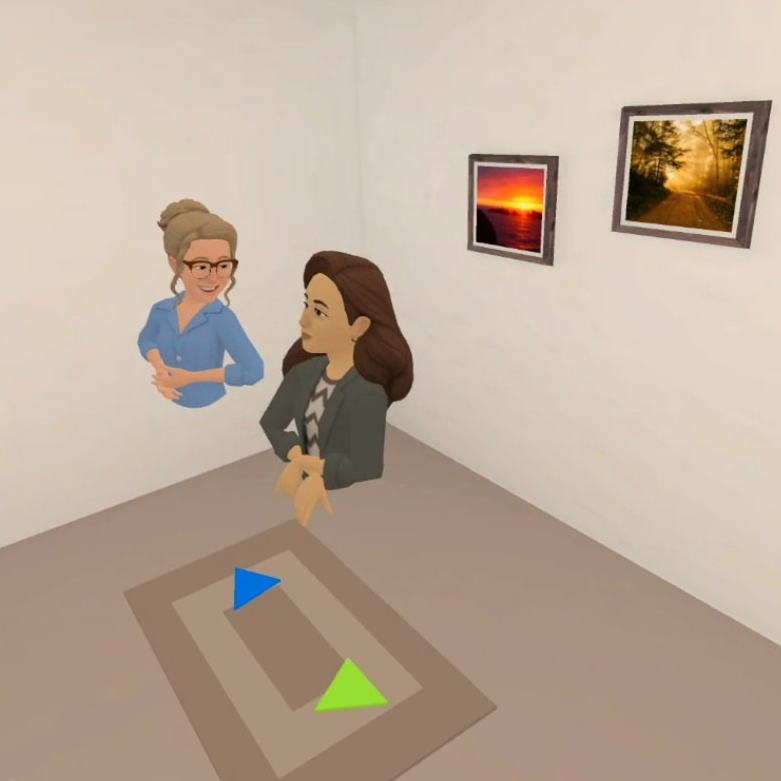
TECNIS: Immersive Teleclinic
Patient Experience
Trace-based Activity Analysis
Trace-based Systems
VR and Psychotherapy
Virtual Reality
Designing and evaluating patients' journeys in a virtual teleclinic to carry out series of neuropsychological tests with practitioners.
Details
Partners: LS2N, CHU Nantes, BioSerenity
Funding: Plan de relance.
Cofunding:
Beginning: 2022-09-01
End: 2024-08-31
Select another theme:
Accessibility
Affordances
Data Visualization
Digital Instruments
Document Engineering
Experience analysis and modelling
Hypervideos
Immersive Analytics
Interpretation Systems
Knowledge Engineering
Learning Analytics
Patient Experience
Progressive analytics
Reflective Systems
Technology-Enhanced Learning
Trace-based Activity Analysis
Trace-based Systems
VR and Psychotherapy
Video Annotations
Virtual Reality








